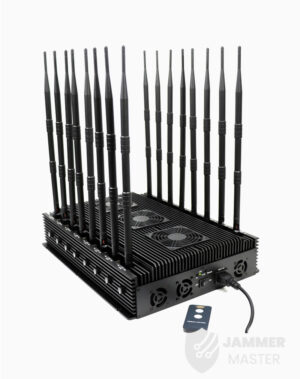
How to Block Drones with a Drone Jammer
In an age where the sky is dotted with drones, the importance of drone jammers has never been more significant. From commercial deliveries to personal

Wireless signal blockers, also known as signal jammers, are devices used to block or disrupt wireless communication signals. They are commonly used in various settings, such as prisons, theaters, and examination halls, to prevent unauthorized use of mobile phones or other wireless devices. However, when installing wireless signal blockers, certain factors should be taken into consideration to ensure their effectiveness and proper functioning.

Mini GPS Jammer & Power Bank Block GPS/GLONASS & CDMA Signals JM015
$599.00
Handheld Mobile Phone Jammer 16 Antennas 25 Meters JM018
$699.00
Desktop 5G Cellular Signal Jammer Block Cellular/Wireless/GPS/LoJack JM006
$1,839.99
Desktop All-in-One Signal Jammer Block Full Band Cellular/WiFi/GPS/LOJACK JM014
$899.00The installation height of a wireless signal blocker should ideally be no lower than 1.8 meters from the ground. This height ensures that the blocker can effectively cover the desired area and minimize signal interference.
It is crucial to install the signal blocker at a considerable distance from base stations. The closer the signal blocker is to the base station, the smaller the range of signal blocking. Therefore, it is recommended to position the blocker far away from base stations to achieve optimal results.
Before powering on the wireless signal blocker, it is important to ensure that the external antenna, if applicable, is securely connected. The antenna should be tightened and kept in a vertical position. The markings on the antenna should correspond to the labels on the main unit’s antenna ports. It is strictly advised not to power on the signal blocker without connecting the antenna to prevent any potential damage to the device.
To assess the effectiveness of a wireless signal blocker, it is recommended to conduct on-site testing using multiple mobile phones from different network carriers. This method provides a convenient and straightforward way to evaluate the performance of the blocker, especially for non-professionals who may not have access to specialized testing equipment. The following steps outline the testing process:
Proper installation and testing of wireless signal blockers are essential to ensure their effectiveness in blocking wireless communication signals. By following the recommended installation height, maintaining a suitable distance from base stations, and conducting thorough testing using multiple mobile phones, users can determine the range and efficiency of the signal blocker. These guidelines provide a practical approach for individuals without specialized knowledge or testing equipment to assess the performance of wireless signal blockers accurately.
Our frequency checker tool will help you check all frequency bands used in all country.

In an age where the sky is dotted with drones, the importance of drone jammers has never been more significant. From commercial deliveries to personal

Protect your vehicle’s location privacy with a professional guide on GPS jammers. From selection to legal considerations and installation tips, we’ve got you covered. Key

Here’s a step by step guide on how to build your own GPS jammer. Below are the main steps we are going to introduce in

Understanding Signal Blocker: How It Works and Its Applications Signal Blockers are devices that can disrupt mobile phone signals, preventing them from connecting to base

The Application and Benefits of High-Power Signal Jammers Enhancing Signal Blocking Efficiency in Various Environments In today’s technologically advanced world, the need for effective signal

Considerations for Purchasing Exam Room Signal Jammers Ensuring Effective Signal Jamming for Exam Integrity As the year approaches its end, many schools are preparing for

The Importance of Monitoring and Signal Interference Measures During Examinations During examination periods, it is crucial to closely monitor the examination venues and their surrounding

Selecting the Appropriate Cell Phone Jammer for Theaters and Auditoriums Overcoming Challenges in Installation and Maximizing Signal Disruption The Importance of Cell Phone Jamming in

Remote Control of Cell Phone Jammers via Smartphone: A Possibility? With the rapid development of the Internet of Things (IoT), numerous smart home devices have

Supplying high quality signal jamming devices since 2010. The only jammer store you can trust.
Jammer Master © 2024. Premium Signal Jammer Supplier Since 2010.